後殖民不干涉指令
Postcolonial Noninterference Directive
包德樂 Dean Anthony Brink
我發現自己在研究、詩歌和繪畫中探索,反映出我在美國的生活與在台灣的生活之間的差異。二十年前,當時我作為一名和平活動家(依需求而為),曾組織詩歌朗讀會(甚至小到無法引起聯邦調查局的注意),而今在台灣的生活與此截然不同。在這裡,和平理想無法與現實的政治現狀契合,至少在短期內,強硬的威懾似乎是維護和平的唯一明顯手段。這樣的情境迫使我不僅僅面對一個尷尬的邏輯矛盾,還讓我意識到,從世界許多地方的視角來看,我在美國生活中所設想的絕對和平的假設其實是天真的。如今,冷戰後世界中和平將永遠存在的理想已經破滅:普京入侵烏克蘭,習近平威脅台灣。然而,我們不應忘記,美國以虛假理由入侵伊拉克同樣是無恥、大膽和帝國主義的,某種程度上也為未來的戰爭創造了可能。最近,特朗普威脅要入侵巴拿馬、格陵蘭甚至加拿大。在這一切當中,《星際迷航》作為一個推測性世界脫穎而出,提供了一個在後稀缺經濟中進行克制與合作的模式,並帶來希望。
I find myself exploring in research, poetry, and painting, the disparity between my life in America as a peace activist (as the occasion demanded), organizing poetry readings (barely large enough to draw the attention of the FBI) twenty years ago, and my life in Taiwan since. Here, such ideals of peace do not mesh well with our realpolitik situation, one in which, at least in the short term, brute deterrence appears the only obvious means of maintaining peace. This situation forces me not simply into an awkward logical contradiction, but a position of realizing that the very assumption of absolute peace as envisioned in my life in America was naïve from the standpoint of many places around the world. Now, the ideal that in the post-Cold War world peace would prevail indefinitely has been shattered: Putin invades Ukraine, Xi threatens Taiwan. Yet we should not forget how the US invasion of Iraq under false pretenses was just as shameless, brazen, and imperialist, in some way shaping the possibility for future wars. Recently, Trump is threatening to invade Panama, Greenland, and even Canada. In the midst of all this, Star Trek stands out as a speculative world that offers hope in a model for restraint and cooperation within a future post-scarcity economy.
包德樂Dean Brink
塔科馬補給艦Tacoma Supply Ships, 2024
壓克力、鉛筆、筆墨、雷射印刷轉印、帆布 Acrylics, pencil, pen and ink, laser print transfer on canvas
30 × 40 cm (12 × 16 in)
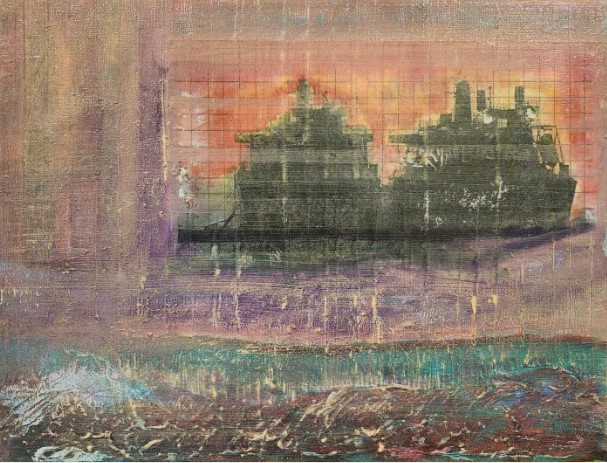
包德樂 Dean Brink
Commemorative Plaque, 2025
壓克力、雷射印刷轉印、筆墨、壓克力造型膏、帆布 Acrylics, laser print transfer, pen and ink, modeling paste on canvas
30 × 40 cm (12 × 16 in)
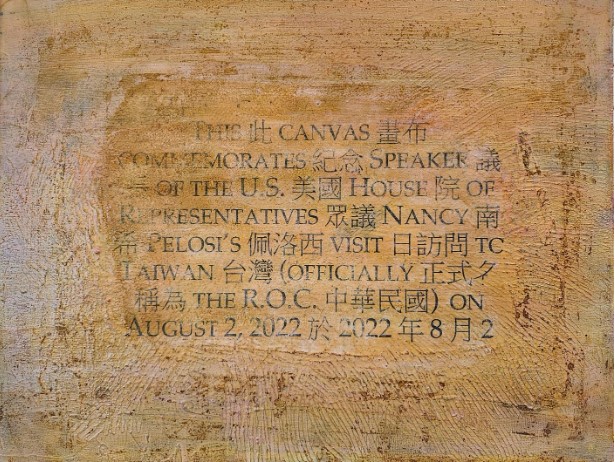
包德樂 Dean Brink
紀念牌匾第二 Commemorative Plaque #2, 2025
壓克力、雷射印刷轉印、筆墨、帆布
Acrylics, laser print transfer, pen and ink on canvas
27 × 41 cm (10.5 × 16 in)
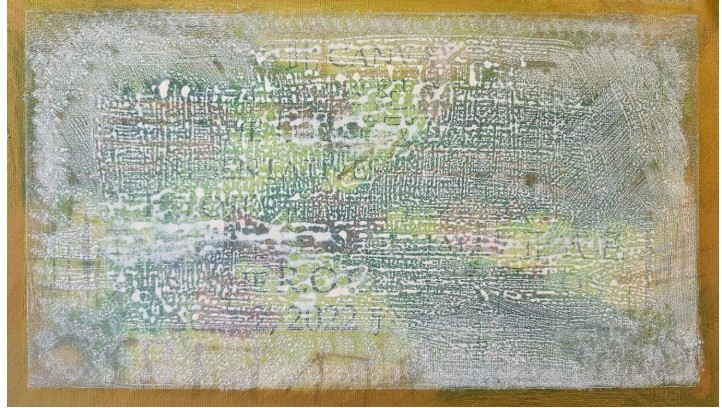
包德樂 Dean Brink
外交的任務 Diplomatic Mission, 2025
壓克力、鉛筆、粉彩、筆墨、帆布 Acrylics, pencil, pastel, pen and ink on canvas
50 × 50 cm (20 × 20 in)
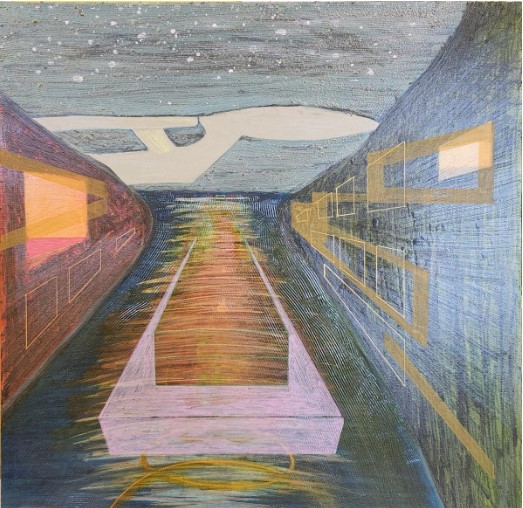
包德樂 Dean Brink
Communications: Air and Sea, 2025
壓克力、壓克力造型膏、筆墨、雷射印刷轉印、帆布 Acrylics, modeling paste, pen and ink laser print transfer on canvas
30 × 40 cm (12 × 16 in)
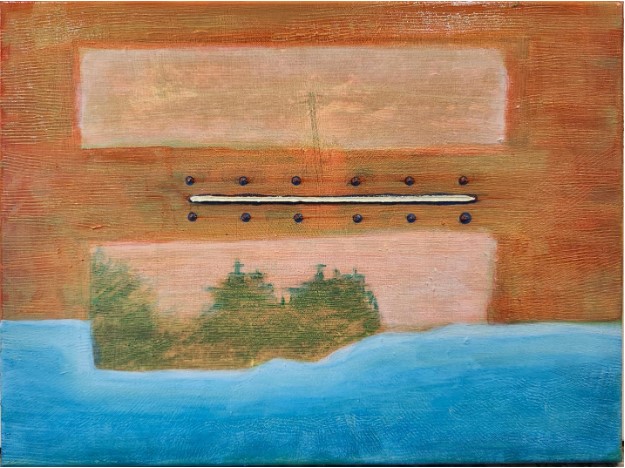
包德樂 Dean Brink
場所:情境矩陣—體現/直覺 Place: Situational Matrix—Embodiment/Intuition
壓克力、鉛筆、筆墨、雷射印刷轉印、帆布
Acrylics, pencil, pen and ink, laser print transfer on canvas
40 × 50 cm (16 × 20 in)
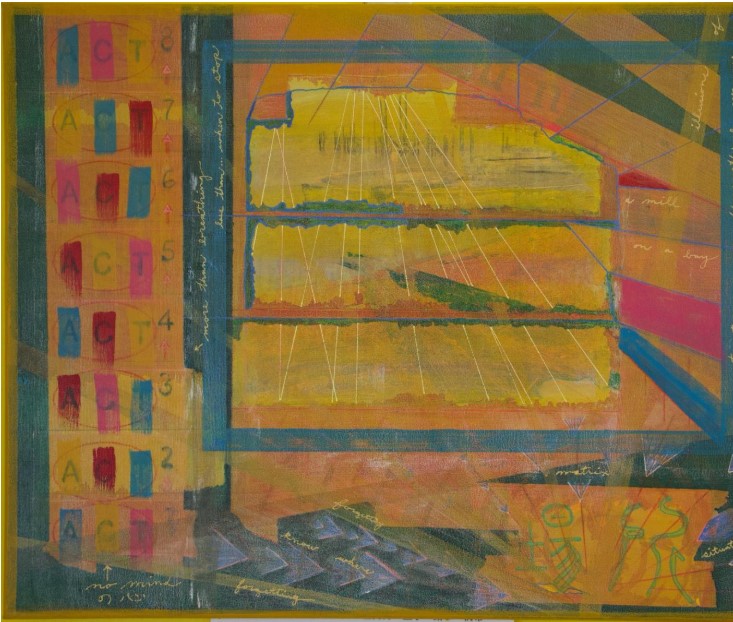
包德樂 Dean Brink
遵守最高指導原則 Minding the Prime Directive, 2025
壓克力、鉛筆、筆墨、帆布 Acrylics, pencil, pen and ink on canvas
31.5 × 41 cm (12.5 × 16 in)
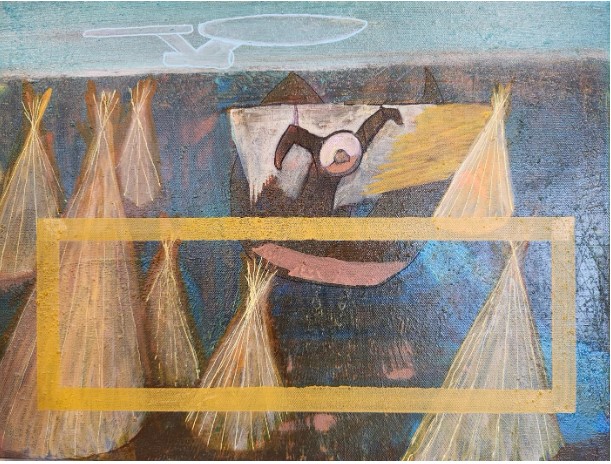
包德樂 Dean Brink
消失的邊界:連貫系統 Vanishing Borders: Coherence System, 2025
壓克力、鉛筆、鉚釘、筆墨、帆布 Acrylics, pencil, rivets, pen and ink on canvas
30 cm 直徑 radius (12 in 直徑 radius)

包德樂 Dean Brink
是/否:地勤人員 (羽田機場) Yes/No: Ground Crew (Haneda Airport), 2025
壓克力、筆墨、雷射印刷轉印、帆布 Acrylics, pen and ink, laser print transfer on canvas
72 × 60 cm (28 × 24)
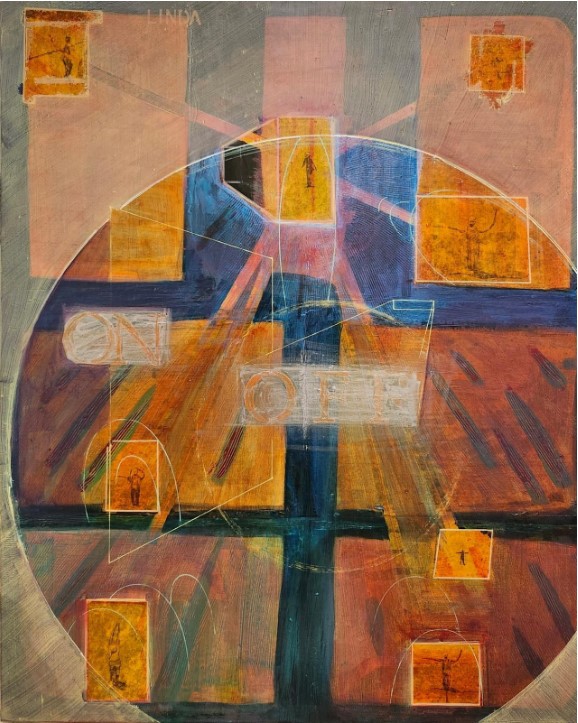
你從哪裡來?Where Are You From? 2025
壓克力、鉛筆、筆墨、帆布 Acrylics, pencil, pen and ink on canvas
41 × 27 cm
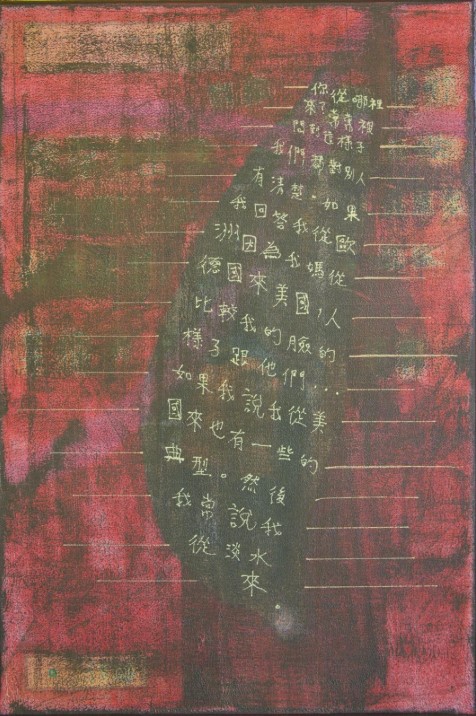
包德樂 Dean Brink
臺灣能幫忙:第一島鏈 (#鏈接) Taiwan Can Help: First Island Chain (#link), 2024
壓克力、鉛筆、筆墨、帆布 Acrylics, pencil, pen and ink on canvas
50 × 40 cm (19.5 × 15.7 in)

包德樂 Dean Brink
最高指導原則 Prime Directive, 2025
Acrylic, ink, charcoal on canvas 壓克力、墨水、木炭、帆布
40 × 50 cm
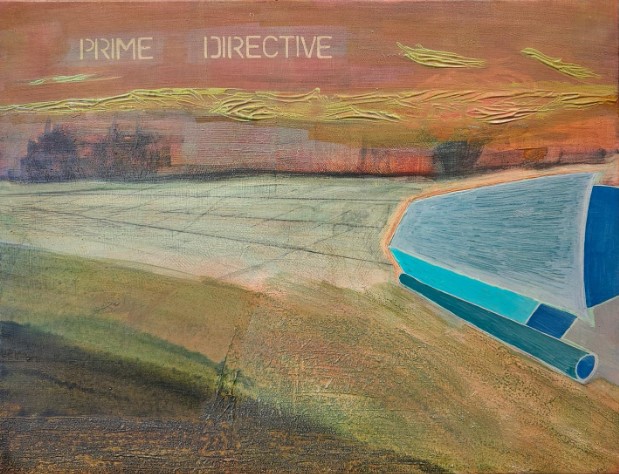
關於帶有《星際迷航》圖像的畫作的註解
《星際迷航》電視劇(1966–1969)至《奇異新世界》(2022年至今)以其應對不斷演變的後殖民動態和在世界各地尚未解決且反覆出現的政治衝突中的模糊邊界而著稱。 《星際迷航》中的「最高指導原則」精神——「不干涉」——提出了一個工作模型,不僅旨在遏制後殖民殘餘的權力結構和基礎設施,同時也透過這種對於限制與包容差異的權力的認識,促成對殖民主義傲慢的重新概念化。
Note on Paintings with Star Trek Imagery
The TV series Star Trek (1966–1969) through Strange New Worlds (2022–present) are known for meeting the challenges of evolving postcolonial dynamics and flickering ethereal borders on the cusp of unfinished and recurrent political conflicts around the world. The “Prime Directive” ethos of “non-interference” in Star Trek articulates a working model for not only restraining postcolonial residual power configurations and infrastructures but the enabling – through this very recognition of the power to engage in restraint and tolerance of difference – a reconceptualization of colonial hubris itself.
關於兩艘船的畫作的註解
在美國一個充滿陸軍、海軍和空軍基地的地區長大時,我從未想過有一天我們可能會遭到入侵。如今,作為一名擁有雙重國籍的台灣居民,第一次我感受到小國在這個由後發展的前帝國主導的時代中的脆弱,那些國家的領袖會塑造他們的人民和資源,試圖恢復失落的榮耀,就像是要修正過去的創傷性地緣政治變遷。我會面對這樣的情勢變化,實在讓我生活中的核心價值變得更為複雜。在一個顯示出自身濫用的文化中成長——例如美國擁有一個帶有種族歧視的雙層特權與司法體系,目睹美國在越南和伊拉克的干預,以及它在拉丁美洲的威脅與干涉(我曾失去一位朋友,Ben Linder,他在尼加拉瓜被中情局支持的反革命武裝殺害)——像一些美國公民一樣,我對於冷漠的無情和事實上的殘酷感到羞愧,這些都助長了如此不必要的暴力行為。我們今天可以在普京和習近平的扑克臉上見證到這種冷漠。然而,面對我們自己對正義的渴望,並且如何真誠地與陷入民粹主義和陰謀論的對手彌合差距,我們該如何處理?我們應該如何被視為台灣人?
Note on Paintings with Two Ships
Growing up in an area of America replete with army, navy, and air force bases, the thought never crossed my mind that we might be invaded one day. Now, as a dual citizen living in Taiwan, for the first time I feel the vulnerability of smaller countries in an age of later-developing former empires, whose leaders would shape their populations and resources to reclaim lost glories as if to rectify traumatic geopolitical changes of the past. That I would be faced with such a surprising change of situation has greatly complicated core values in my life. Having come of age in a culture that exhibits its own abuses – such as having a racialized two-tiered system of privilege and justice in the US, witnessing American interventions in Vietnam and Iraq, its threatening and meddling in Latin America (losing a friend, Ben Linder, to CIA-backed Contras in Nicaragua) – like some American citizens, I feel shame for the cold indifference and de facto cruelty that enables such unnecessary acts of violence. We can all witness this indifference in the poker faces of Putin and Xi today. Yet how can we deal with our own thirst for justice and bridge the gap with adversaries given over to populism and conspiracies in good faith? How are we to be seen as Taiwanese?
「是/否:地勤人員(羽田機場)」的註解
在這裡,決策過程——是與否——以犧牲、勞動以及其他較低階地勤人員的角度呈現,這些人來自東京羽田機場的世界。當個人的過去經歷影響他們的觀點時,當地的習俗如何在地勤人員之間,以及在與他人互動時,發揮作用?」
Note on Yes/No: Ground Crew (Haneda)
Here decision-making – yes and no – is presented in terms of sacrifices, labor, miscellaneous lower-ranking members of a crew in the world of Haneda Airport in Tokyo. How are local customs situated among the crew and in engaging others when personal backstories bias their views?
關於「最高指導原則」及其與時間和歷史的關係的註釋
「最高指導原則」是星際艦隊的一項不干涉其他外星國家及其情況的規範。它禁止分享先進技術,以避免改變當地歷史的發展。這與冷戰時期對核武擴散的恐懼以及對新興且常常現代化的獨立國家的去殖民化敏感性有關。它在某種程度上假設了一種普遍的線性技術發展,然而這種發展在遙遠的文化中以獨特的方式呈現。「最高指導原則」假設某些社會已達到或尚未達到某一技術水準,這一標準的試金石就是:他們是否能夠離開自己的太陽系並進行所謂的超光速旅行——不論他們如何實現這一目標。
它同時形成了一種外星人使用的工作概念,這些外星人擁有超越人類的技術,並且正在測試人類,有時是為了判斷人類是否值得繼續存在,或應該為了宇宙的更大利益而被滅絕。在某種程度上,這樣的「翻盤」也顯示了「最高指導原則」如何構成對種族滅絕的概念性批判,尤其是當考慮到這種價值判斷本身如何被用來突出那些沒有「最高指導原則」的、技術上優越的外星人所帶來的迫在眉睫的威脅。
Note on the Prime Directive and Its Relation to Time and History
The Prime Directive is a Starfleet code of non-interference in other alien states and their situations. It prohibits sharing advanced technology, not to alter the course of local histories. It maps to the Cold War fear of the proliferation of nuclear weapons as well as a decolonizing sensitivity to emerging and often modernizing independent states. It assumes to some extent a universal linear technological development that nevertheless is manifest in unique ways in far-flung cultures. The Prime Directive assumes societies have or have not reached a certain level of technical capability, namely the litmus test of whether or not they are able to leave their solar system and engage in so-called warp travel: travel faster than the speed of light, by whatever means they achieve it.
It also forms a sort of working concept used by aliens with superior technology that are testing humans themselves, sometimes to determine whether they are worthy of continued existence, or should be exterminated for the greater good of the universe. In a way, such table-turning also shows how the Prime Directive forms a conceptual critique of genocide, especially when considering how such valuation itself may be invoked to highlight the looming threat of technologically superior aliens who have no Prime Directive themselves.
